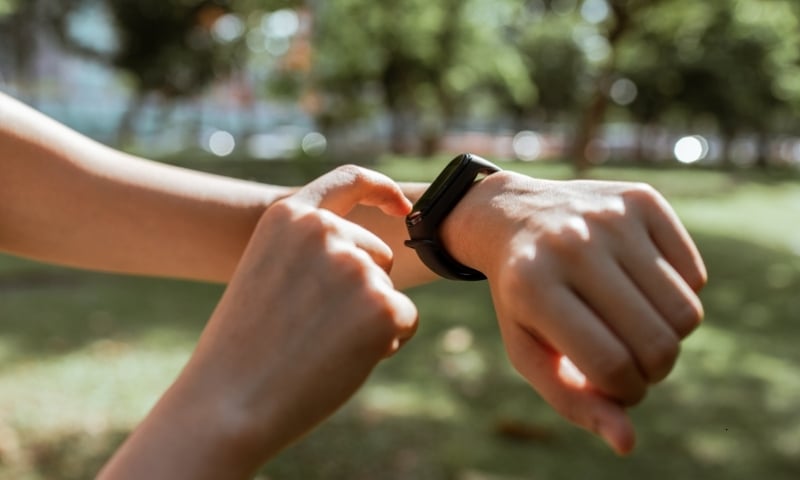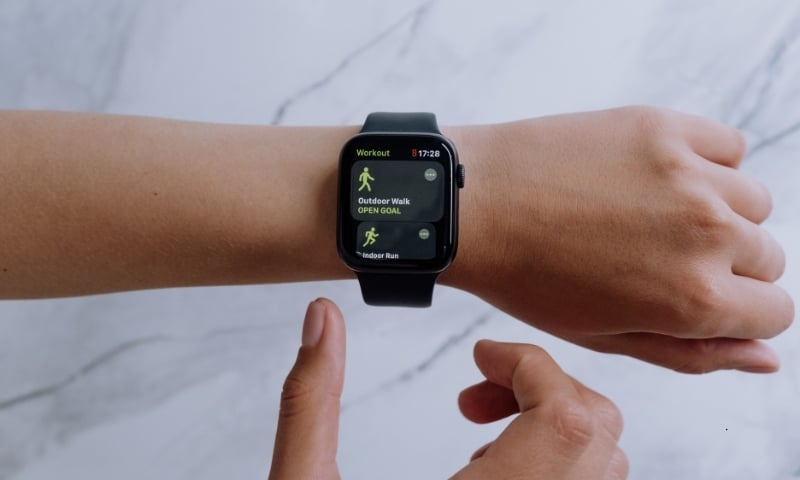Why is my VO2 Max Going Down?
VO2 Max reflects how efficiently your body uses oxygen during exercise. It’s one of the strongest indicators of your aerobic fitness, endurance, and even life expectancy.
If your VO2 Max is dropping, it doesn’t necessarily mean you’re out of shape. But it usually means something has changed.
In this article, I’ll break down why your VO2 Max might be dropping, what your tracker could be missing, and how to get a clearer picture of your fitness and health.
Key Takeaways
- VO2 Max shows how well your body uses oxygen during exercise.
- Trackers give estimates, not exact VO2 Max readings.
- A drop doesn’t always mean you’re less fit; it could be age, changes in how much cardio vs strength training you do, or something reducing your ability to breathe well during the test, like sleep apnea.
- Cardio boosts VO2 Max the best.
- Our test shows you if you need more cardio vs strength vs interval training to reduce biological age and burn more calories.
- Poor sleep, stress, and diet could all lower your VO2 Max.
The Causes of a Low VO2 Max
Not Enough Cardiovascular Training
Cardiovascular exercise may increase VO2 Max. Examples are:
- Running
- Biking
- Swimming
- Walking
- Hiking
…and many others. Anything that gets the heart pumping! We will provide you with your personalized ideal plan using your own breath.
While traditional cardiovascular exercises, such as running and cycling, are most effective at directly improving VO2 Max, resistance training also plays a role. In fact, combining strength training with cardio may be more effective at improving overall fitness than cardio alone.
If your routine is heavily strength-focused, your VO2 Max might not rise as quickly, but that doesn’t mean your fitness isn’t improving.
It’s about balance, and we help you find the ideal mix based on your personal data.
Inaccurate Measurements on Trackers
Apple Watches are great for tracking exercises, but they only provide an overview. Smartwatches usually estimate VO2 Max through algorithms, not precise measurements.
If you want an exact number, you need to measure how much oxygen you inhale and how much carbon dioxide you exhale. Your smartwatch or exercise tracker can’t detect your breath.
Trackers rely on the data they can collect using:
- Heart rate
- GPS data
- Step count
- Duration of exercise
- Weight
- Age
…and then run it through a complex algorithm to estimate VO2 Max. It’s usually a good ballpark, but it’s still just an estimate.
At our clinic, we use clinical-grade breath analysis to measure your actual oxygen uptake, no guesswork, just data.
Fitness trackers estimate your VO2 Max using heart rate and movement data. Clinical testing, like we offer, directly measures your oxygen and carbon dioxide exchange through breath analysis, giving you a more accurate result.

Genetic Factors
Genetics do play a role in VO2 Max, but it’s smaller than many think. While early research identified dozens of potentially associated genes, only a handful have been consistently validated in further studies. That means your VO2 Max isn’t “set in stone” by your parents — your training, sleep, stress, and recovery still make the biggest difference.
Some people may have slight advantages in how efficiently they use oxygen or convert fat to energy, but most individuals can see meaningful improvements with the right type of exercise for their body.
Why is My VO2 Max Dropping?
Again, your VO2 Max could be decreasing for many reasons – some temporary (like illness), some long-term (such as aging).
If your VO2 Max reading on a wearable device shows a drop, it may be an estimate rather than a precise measurement. For a true picture of your performance and oxygen usage, clinical-grade testing like ours is essential.
That said, if you’re still seeing a drop in your VO2 Max, here are the main reasons this could be:

Not The Right Exercise Routine
Remember, we said cardio is the way to get your VO2 Max up?
Well, if you switched things up to focus just on strength training or lifting weights, this could be one reason for your VO2 Max going down. Although one could argue that more muscle helps you get the lead out on the exercise bike! Another reason could be the reduced intensity of your cardio workouts.
Any change in your exercise routine should be noted when looking at trends in your VO2 Max.
Muscle Mass
If you’ve been focused on lifting and gaining lean mass, great job. While building lean muscle mass can reduce your VO2 Max, it’s not guaranteed to. In fact, it can enhance oxygen efficiency if paired with regular cardio. Some very muscular people may see changes in tracker estimates due to shifts in body composition, but clinically measured VO2 Max often improves when strength and aerobic training are balanced.
Some patients appear fit because they work out like crazy. Their lungs simply can’t keep up with the exchange of oxygen in and carbon dioxide out. A change in weight can make you seem less efficient. Pairing that strength work with regular cardio can help keep you more balanced.
Combining body fat analysis with VO2 Max is an important part of our practice. For an expert assessment to help you balance the effects of muscle mass on VO2 Max against your fitness goals, get in touch!

Age
Sorry, you can’t blame your parents for this one! VO2 Max declines with age. That’s the case for marathon runners and us normal folks. The drop is usually a steady one.
But you can maintain a decent VO2 Max and even increase it with a sustained workout. You can also cheat and try things like Hyperbaric Oxygen Therapy to help recover from any harsh strain on your body.
Sleep, Stress, and Snacks
Lack of sleep, high stress, and a poor diet could all contribute to a lower VO2 Max. They are interlinked: stress leads to poor sleep, which increases cravings for sugary, processed snacks.
A bad diet reduces exercise tolerance and the ability to recover from exercise, which compounds stress levels…you get the picture.
And exercise trackers use your heart rate to calculate VO2 Max. A lower heart rate means your heart is pumping more efficiently and indirectly correlates with VO2 Max.
Stress increases the levels of the hormones cortisol and epinephrine, which raises your heart rate. Stress may lead to a lower VO2 Max reading.

Medical Conditions
Underlying medical conditions may decrease VO2 Max. This could be a subtle sign of something undiagnosed. These include:
- Anaemia
- Heart conditions
- Diabetes mellitus
- Thoracic Outlet syndrome
- COPD and asthma
- Sleep apnea
It’s important to remember that these conditions are going to cause lots of other symptoms too.
If you feel fit and are training well, and the only thing you’re noticing is a declining VO2 Max, it is best to consult with a medical professional to figure it out. There’s no single answer. VO2 Max is an important indicator. It is not meant to take the place of normal blood work. If you are fluctuating on your wearable, get a better test to ensure better results.
Changes in VO2 Max can happen without much explanation. That is why we advocate for patients looking to improve their performance to get more than one result. Patterns over time give us the best information. What better way to figure out if it is time to make a change in your diet, or if you just need to adjust your routine?
And the good news is, there are solutions!

What’s the Solution?
Work on a Structured Exercise Routine
As we get older, a balanced exercise routine becomes more and more important. Keeping up with cardio will maintain a good VO2 Max, but you don’t want to ignore strength and balance. It can be so hard to fit this all in!
But with a bit of research, it’s very achievable.
Get Your VO2 Max Measured By a Specialist and Receive a Personalized Report
Want to know your exact VO2 Max? At the Young Naturopathic Center for Wellness, we perform precise VO2 Max testing.
First, you’ll do 10 minutes of relaxed breathing with an oxygen mask to measure how much oxygen you inhale and how much carbon dioxide you exhale.
Next, a short 10-minute workout on an exercise bike will show how your body uses oxygen during exertion.
This gives us your VO2 Max score, which we include in a 15–20 page personalized report.
We’ll tailor the results to your goals, age, and fitness level and recommend the right diet and exercise plan for you.
Ready To Get Serious About Your Performance?
Book Your VO2 Max Test Now at Young Wellness Center
FAQs
How Quickly Does Your VO2 Max Go Down?
VO2 Max starts dropping within weeks of stopping training, with the biggest decline usually happening in the first couple of months.
What Does a Decrease in VO2 Max Mean?
A decrease in VO2 Max means your body is not using oxygen efficiently. This will happen if you stop exercising or ignore cardio. It can also decline from poor diet choices. If your body is not burning fuel well, your demand for oxygen will change.
Does VO2 Max Decline with Age?
Can Low Iron Cause Low VO2 Max?
Yes, low iron could be a cause of a low VO2 Max. Iron is an essential part of transferring oxygen to muscles. Low iron means that the process of oxygen transfer becomes less efficient, thus lowering VO2 Max.
What’s a Bad VO2 Max?
What Does a Sudden Drop in VO2 Max mean?
A sudden drop in VO2 Max could be caused by a number of things. These include:
– Illness
– Injury
– Inaccurate measurement, including a faulty exercise tracker
– Over-exercising, including poor recovery
Can Overtraining Decrease VO2 Max?
Yes, overtraining can lower VO2 Max. Exercise should match your age, fitness level, and recovery needs. More intensity means more rest and better nutrition.

